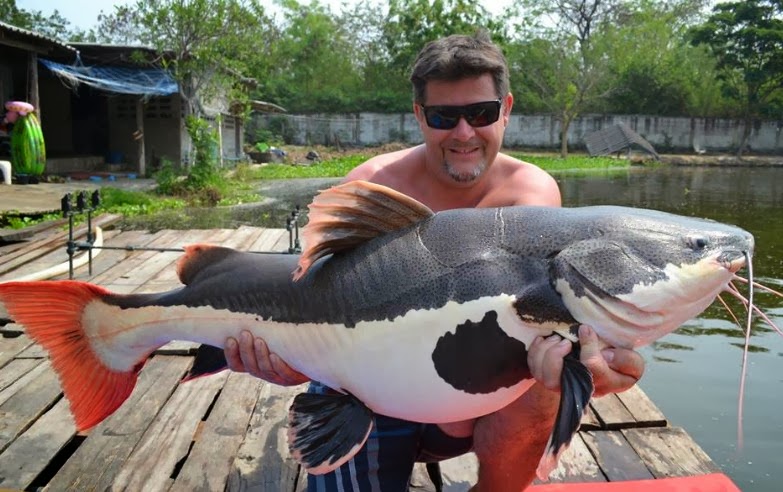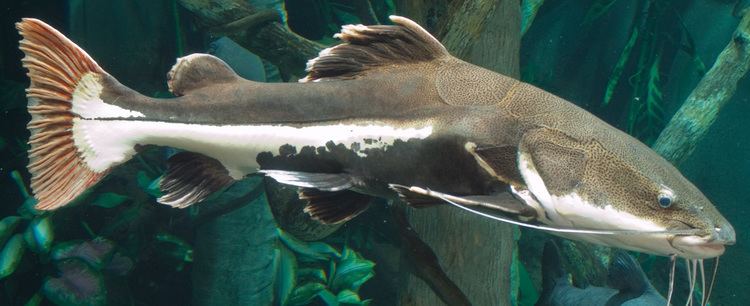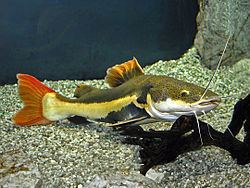Phylum Chordata Rank Species | Higher classification Phractocephalus Order Catfish | |
Genus PhractocephalusAgassiz, 1829 Scientific name Phractocephalus hemioliopterus Similar Catfish, Pseudoplatystoma fasciatum, Tambaqui, Cichla, Phractocephalus | ||
Redtail catfish 72 inch fish tank light and inside the fluval 406 3 of 4
The redtail catfish, Phractocephalus hemioliopterus, is a pimelodid (long-whiskered) catfish. In Venezuela it is known as cajaro and in Brazil it is known as pirarara. It is the only extant species of the genus Phractocephalus. This fish is common in the aquarium trade, although its massive adult size makes it unsuitable for all but the largest aquariums.
Contents
- Redtail catfish 72 inch fish tank light and inside the fluval 406 3 of 4
- Extinct Phractocephalus
- Description
- Distribution and habitat
- Relationship to humans
- In the aquarium
- References

Extinct Phractocephalus

Although the redtail catfish is the only living representative of this genus, there are other members that date back to the upper Miocene and only are known from fossil remains. P. nassi was described in 2003, and is from Urumaco, Venezuela. Another undescribed member is known to exist from Acre, Brazil. This genus has a minimum age of about 13.5 million years.
Description
Phractocephalus hemioliopterus can reach about 1.8 m (5 ft 11 in) in length and about 80 kg (180 lb) in weight. These colorful large catfishes have a brownish back, with yellow sides and characteristic orange-red dorsal fin and caudal fin (hence the common name). It has a pair of barbels on the upper jaw and two pairs on the lower jaw.
Distribution and habitat

The redtail catfish is native to the Amazon, Orinoco, and Essequibo river basins of South America, in Colombia, Venezuela, Guyana, Ecuador, Peru, Bolivia and Brazil. It is found only in fresh water and inhabits larger rivers, streams and lakes.
Relationship to humans

Due to the potential large size of this species, redtail catfish are considered a game fish by anglers. The current IGFA world record for weight belongs to the Brazilian Gilberto Fernandes with 56 kg (123 lb 7 oz).
It is said that the natives do not eat the meat of the redtail catfish because it is black in coloration. However, the redtail catfish has been hybridized with other fish such as the Tiger Shovelnose Pseudoplatystoma sp. Through the use of hormones in attempts to create a viable food fish, the Tiger redtail catfish; these hybrid fish sometimes make it into the aquarium hobby under a variety of common names.
In Thailand it is alien species, has been introduced for use as a aquarium fish, such as common pleco, zebra tilapia or alligator gar.
In the aquarium
The redtail catfish is an extremely popular fish in Amazonian themed exhibits at public aquaria, where they are often housed with other large fish such as Colossoma macropomum or pacu, and other large catfish.
Juveniles are often available as aquarium fish despite their eventual large size. In an aquarium where they may be well-fed, these fish can grow quite rapidly and require tanks of at least 10,000 l (2,600 US gal) when fully adult. Weekly feeding is appropriate for this catfish; overfeeding is a common cause of death in this species. It feeds heavily on live and dead fishes and other meat. Even as a juvenile of only a few inches in length, they are able to swallow many of the more common aquarium fish such as tetras, and it is only appropriate to house this fish with other species of relatively large size. Redtail catfish also have a habit of swallowing inedible objects in the aquarium. Though these are often regurgitated, both the swallowing and the regurgitation can present a problem for the fish, and these objects are best kept out of the aquarium.
